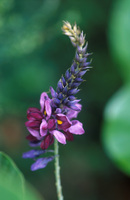 | Back to e-WV
| Back to e-WV
 The West Virginia Encyclopedia
The West Virginia Encyclopedia
 | Back to e-WV
| Back to e-WV
 The West Virginia Encyclopedia
The West Virginia Encyclopedia

Kudzu is a fast-growing, weedy vine of the bean (legume) family. Characteristics of the vine are large three-part hairy leaves; showy, fragrant clusters of deep purple flowers, and fuzzy bean-like pods. It is native to Japan and China, where it has been used in foods and medications and for cattle forage for centuries. It was introduced into the United States in 1876 at a Philadelphia trade exposition, as an ornamental. Kudzu was later planted throughout the South for forage and erosion control.
Kudzu was likely introduced into West Virginia in the 1930s for the same reasons it was planted in the South. It now occurs in more than half of the counties in West Virginia. In southern West Virginia the vine is an aggressive weed that occasionally covers patches of five acres or more along stream banks, roadsides, and forest openings. Most patches in northern West Virginia cover less than one-tenth acre. The vines can grow up to a foot per day and easily overtop brush and trees in ghostly green mounds which smother the life from the underlying plants.
In the southern United States, kudzu covers more than seven million acres of farmland, forests, roadsides, and forest openings. Kudzu vine supposedly cannot withstand the cold winter temperatures of northern West Virginia or in the high mountains. Still, there are healthy populations near the Pennsylvania border in Morgantown and Reedsville. The large roots are a potential source of quality starch for cooking and contain daidzin, which suppresses alcohol addiction.
Written by William N. Grafton